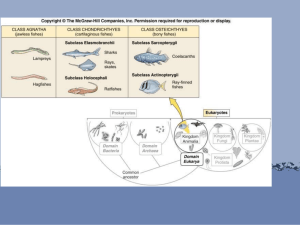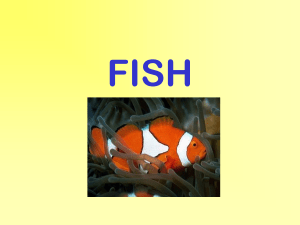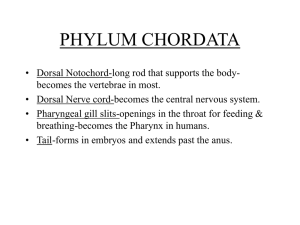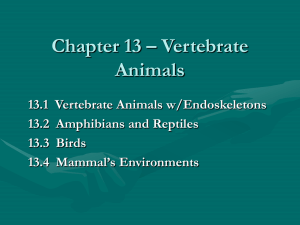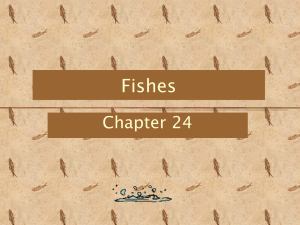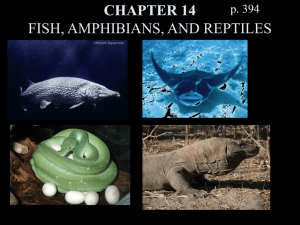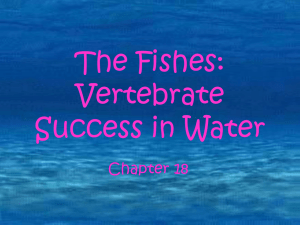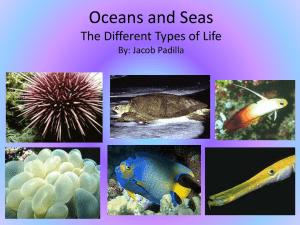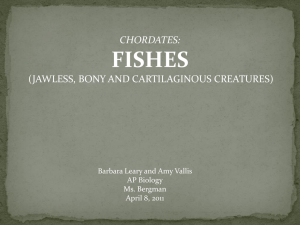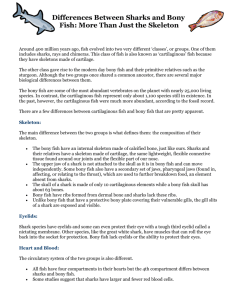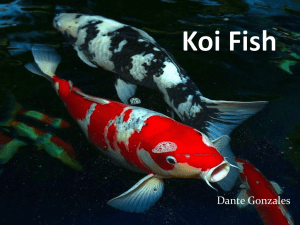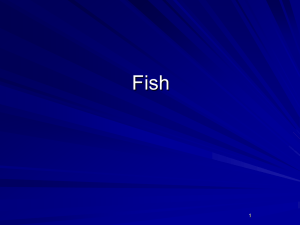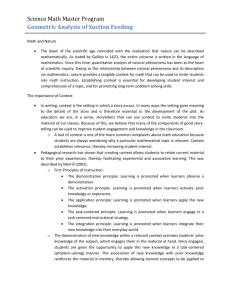Fish feeding behavior integrates morphology with perception to
advertisement
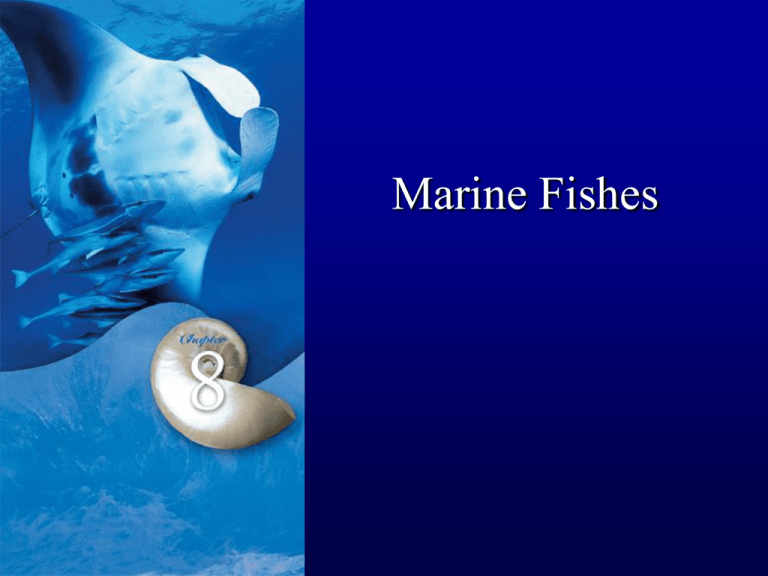
Marine Fishes What is a fish?? Classic definition: -Any of numerous cold-blooded aquatic vertebrates of the superclass Pisces, characteristically having fins, gills, and a streamlined body and including specifically, and... -Any of the class Osteichthyes, having a bony skeleton, and... -Any of the class Chondrichthyes, having a cartilaginous skeleton and including the sharks, rays, and skates. Although this is all accurate...we will find that fish are considerably MORE!! Fish similarities... • • • • Vertebrate ( chordate) Gills Fins Scales What is a fusiform body shape? • • • • pointed leading edge maximum depth 1/3 body length back from head posterior taper caudal fin interrupts ideal fusiform shape Hagfish (Agnatha): jawless fish Lamprey • Predatory/parasitic • Rasping teeth Parasitism of Great Lakes fishes… Cartilagenous Fishes (Sharks, Skates and Rays) Distinguishing Traits cartilaginous skeleton no swim bladder heterocercal tail scales and teeth spiracles present with 5-7 gill slits males have claspers, internal fertilization teeth in rows, are constantly replaced Sharks exhibit extreme variability in size, shape and abilities. Nearly 850 spp. of sharks, 350 exhibit typical body morphology. Variations on this theme are common. Carchariniformes – basking sharks, filter feeder Cetorhinus maximus Mako Isurus oxyrinchus Great White Lamniformes - mackerel, mako, white sharks -carnivores Great White, Carcharodon carcharias Skates and rays spend most of their lives near (on) the ocean floor eating molluscs, squid, and small fish. Yellow stingray, Urolophus jamaicensis Like sharks, skates and rays come in many shapes and sizes. Blue spotted ray, Taeniura lymma Skates (order Rajiformes) •pelvic fin divided into two lobes •tail relatively stocky, no spine Rays (order Myliobatiformes) •each pelvic fin with one lobe •tail relatively slender to whip-like spine Boneless vs. Bony Cycloid and Ctenoid Scales Found in bony fishes (the Teleostei). Overlapping = flexibility, over cosmoid or ganoid scales. Cycloid scales—smooth posterior margin. (Greek "cyclo“ or circle.) Fish form and function show a high degree of variation. Coloration is also very important in fish. Here a stonefish “disappears” amid the coral background. Chromatophores, specialized pigment cells within its skin provide protective coloration. • Disrupt the outline of the fish • Being dark on top, light on bottom – Look like substrate from above – Look like water surface from below Warning coloration! May indicate poisonous amimal. Fish Locomotion • Primary forces involved in fish swimming: – Thrust - force that propels forward – Drag - friction produced from passing an object through a medium – Gravity – force from earth’s magnetic pull (partially counterbalanced by density of water) – Lift - upward force that counteracts gravity Fish Feeding - function • Herbivores – < 5% of all bony fishes, no cartilaginous fishes • browsers - selective eat only the plant • grazers - less selective include sediments • Detritivores – 5 - 10% of all species – feed on decomposing organic matter Fish Feeding - function, cont. • Carnivores – zooplanktivores • suction feeding • ram feeding – benthic invertebrate feeders • • • • graspers pickers sorters crushers Fish Feeding - function, cont. • Carnivores, cont. – fish feeders • • • • active pursuit stalking ambushing luring Fish feeding behavior • Fish feeding behavior integrates morphology with perception to obtain food: – Search – --> Detection – --> Pursuit – --> Capture – --> Ingestion Feeding behavior • Fish show versatility in prey choice and ingestion • Behavior tightly linked to morphology (co-evolution) Damselfish, Chromis spp. Lateral line also aids in navigation in close quarters. Predator avoidance Migration for some salmon is a one-way trip!
